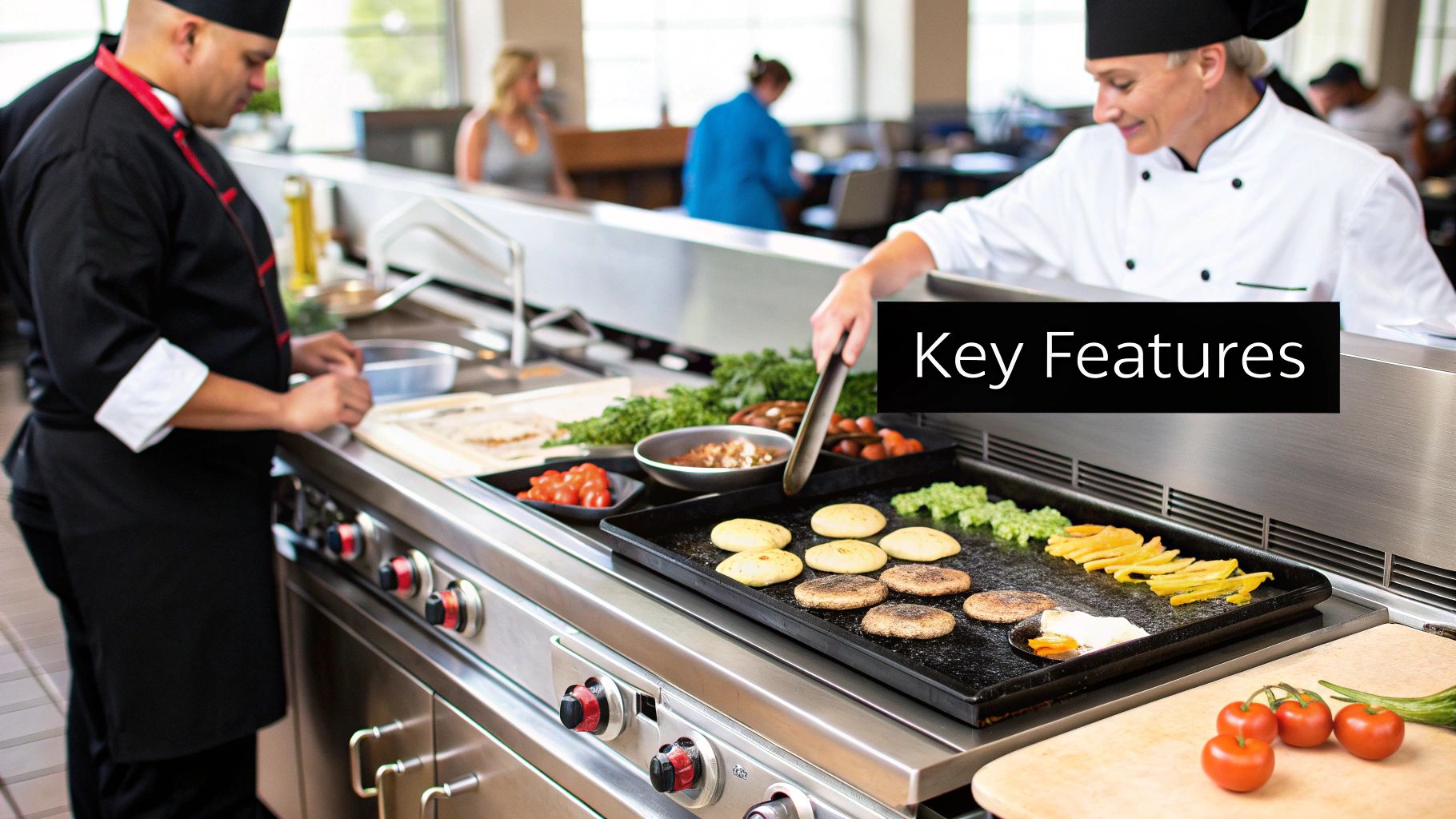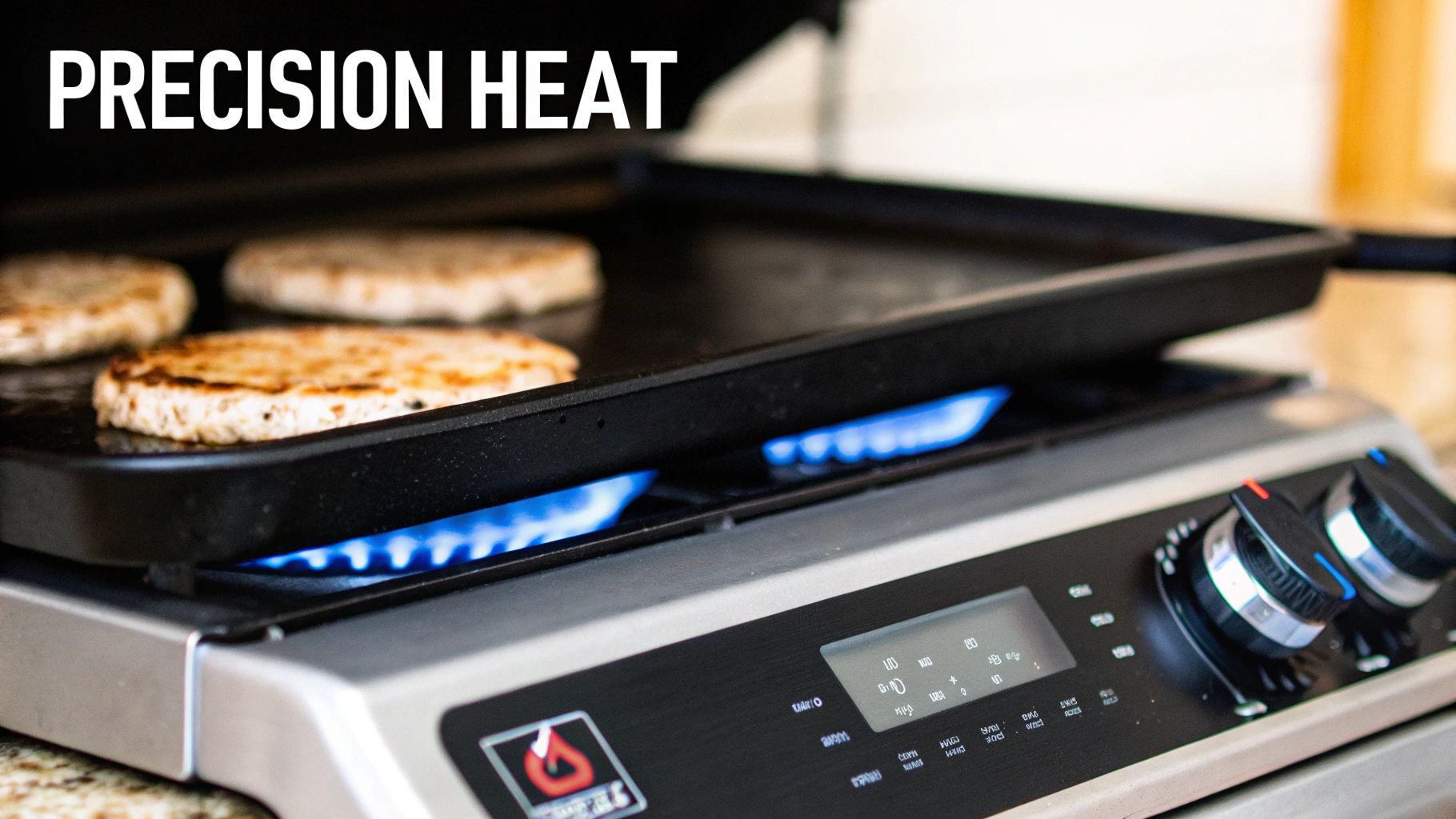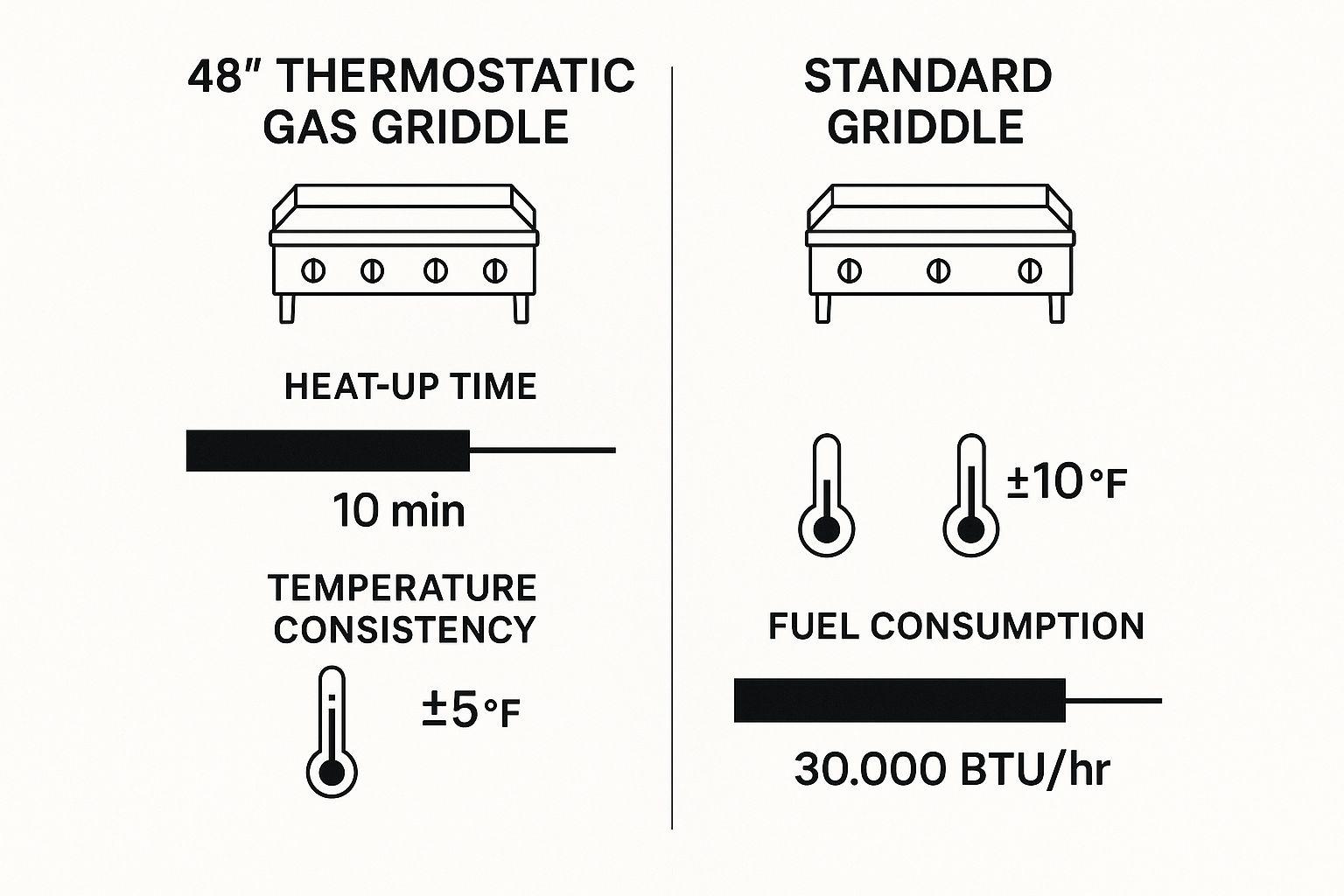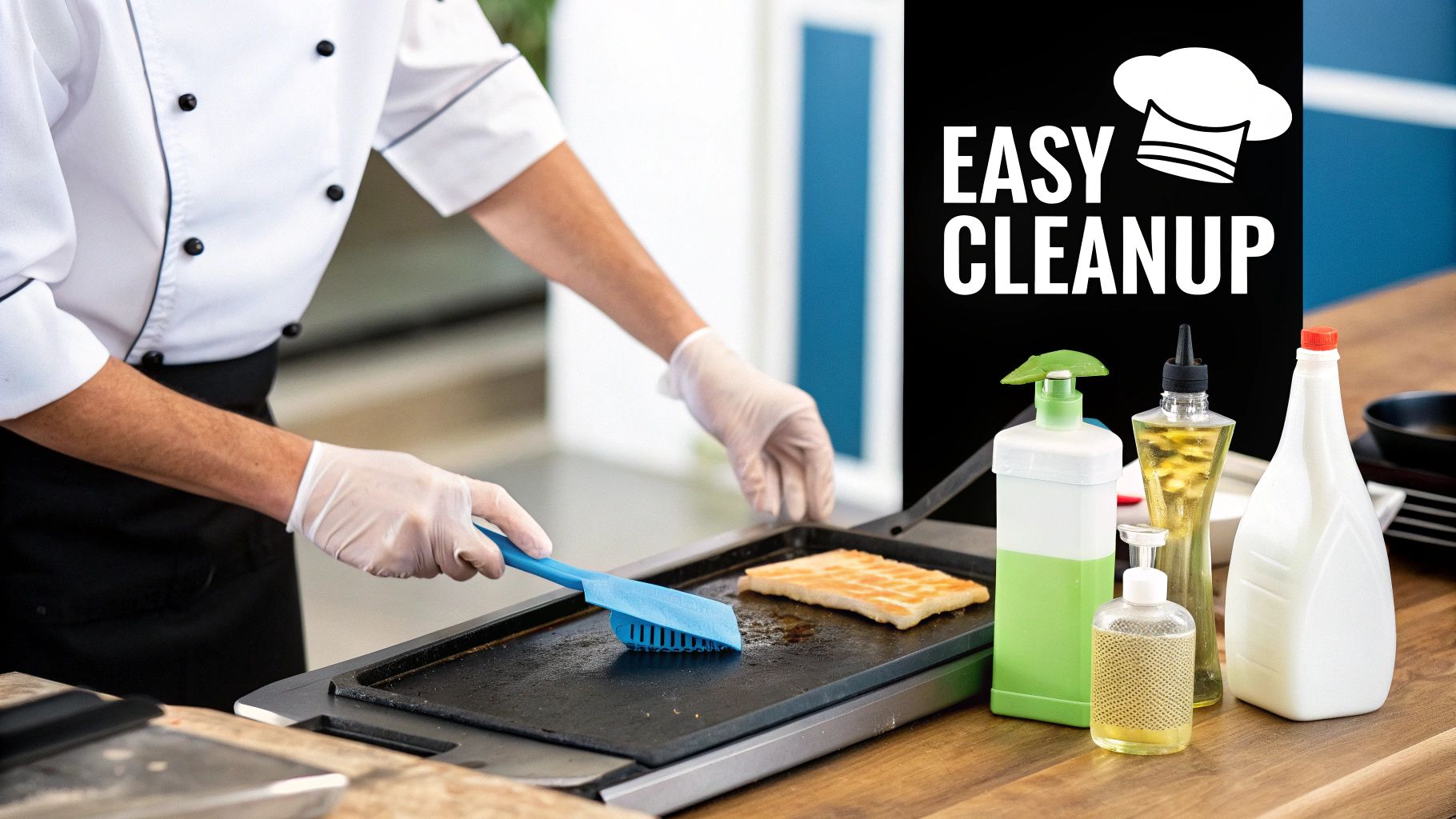
Top 48 Thermostatic Gas Griddle for Precise Commercial Cooking
At its core, a 48 thermostatic gas griddle is a high-volume cooking machine built for precision. It combines a massive cooking surface with automatic temperature controls, making it a true workhorse for any commercial kitchen cranking out breakfast, lunch, or dinner.
Why Your Commercial Kitchen Needs This Griddle

In any professional kitchen, the daily grind is a battle for two things: consistency and speed. A 48-inch thermostatic gas griddle isn't just another shiny piece of stainless steel—it's your secret weapon in that fight. This is the machine that delivers perfectly golden pancakes, flawlessly seared burgers, and consistently grilled veggies, shift after shift.
This guide will walk you through everything you need to know about this essential commercial tool. We'll dive into the technology that makes it tick, compare the must-have features, and cover the basics of safe installation and smart maintenance. By the time we're done, you'll see exactly why this griddle could become your commercial kitchen's most valuable player.
A Foundation of Precision and Power
The real magic behind this commercial griddle comes down to two things: its sheer size and its smart controls. That 48-inch width gives your line cooks an enormous amount of real estate, letting them juggle multiple orders at once. Think about searing steaks on one side while gently toasting buns on the other—that’s a level of efficiency you just can't get from smaller units.
All that space is powered by gas, the undisputed king in professional kitchens for its incredibly fast heat-up and recovery times. When the dinner rush hits and you drop a dozen cold burger patties on the flat top, powerful gas burners kick in immediately to bring the surface right back to temperature. No waiting, no slowing down.
The core advantage here is predictability. A thermostatic control is like cruise control for your griddle. You set the temperature, and it automatically adjusts the flame to hold it there, eliminating hot spots and ensuring every single item is cooked perfectly.
And the demand for this kind of reliable gear is only growing. The global market for commercial griddles is expected to jump from USD 576.4 million in 2025 to a whopping USD 912.4 million by 2035. It's no surprise that gas-powered units are leading that charge. You can learn more about the commercial griddle market trends and what's driving this growth.
Choosing the right 48 thermostatic gas griddle isn't just a purchase; it's a serious investment in your kitchen’s future, one that pays dividends in food quality, speed, and consistency.
How Thermostatic Control Delivers Perfect Consistency

So, what really separates a 48 thermostatic gas griddle from a standard manual one? It all comes down to smart temperature control. A manual griddle requires constant guessing and adjusting. A thermostatic griddle, on the other hand, is like a high-end convection oven—you set the exact temperature you need, and it stays there.
With a manual griddle, a chef is always fighting the temperature. You might turn the knob to "medium," but that temperature will swing wildly the second you drop cold hash browns on the surface. This leads to frustration and inconsistent food—some things burnt while others are barely cooked.
The Mechanics of Precision
The magic behind it all is a built-in thermostat. This sensor acts like an extra set of eyes on the line, constantly monitoring the temperature of the griddle plate. It’s part of a simple, brilliant feedback loop.
When the temperature dips below your target, the thermostat tells the gas burners to kick on. Once it’s back up to where it needs to be, they cycle off. This happens over and over, making tiny, constant adjustments to keep the surface temperature within a few degrees of your setting. This is the key to getting the same perfect results, every single time.
For any busy commercial kitchen, this means one thing: predictability. Your chefs can trust the griddle to hold its temp, letting them focus on plating and prep instead of babysitting the flat top.
The real-world benefits here are huge. You'll drastically cut down on burnt food, which saves a ton of money on food waste. More importantly, it guarantees every customer gets the same quality meal, whether they're your first order or your last. For a closer look at the tech, check out our detailed explanation of what makes a thermostatic griddle a superior choice.
Real-World Impact on Your Commercial Kitchen
During a hectic dinner rush, a 48 thermostatic gas griddle gives you a serious edge. Most commercial models give you independently controlled heat zones. A typical 48-inch unit comes equipped with four burners, each packing 20,000 BTUs of power, letting you create multiple temperature zones across that huge cooking surface.
This is where your kitchen's workflow really gets a boost. Picture this setup:
- Zone 1 (High Heat): Cranked to 450°F to get that perfect sear on steaks and burgers.
- Zone 2 (Medium Heat): Holding steady at 350°F for pancakes, eggs, and bacon.
- Zone 3 (Low Heat): Set to a gentle 200°F for toasting buns or keeping finished items warm.
Being able to multitask like this on one piece of equipment is an absolute game-changer. It makes the whole cooking process smoother, lets you push out more plates, and improves your kitchen’s performance across the board. That’s a level of control you just can’t get from a manual griddle.
Choosing the Right Griddle Plate and Features
When you're shopping for a 48 thermostatic gas griddle, it's easy to get focused on the overall size. But the real magic, the thing that separates a good griddle from a great one, is the hardware under the hood. The single most important part is the griddle plate itself—that's where every pancake, burger, and cheesesteak gets its start.
Most commercial griddles come with a polished steel plate that’s between 3/4-inch to 1-inch thick. A thicker plate takes a bit longer to heat up, but once it's hot, it holds onto that heat for dear life. This is absolutely critical during a dinner rush when you're slapping down cold proteins one after another.
That superior heat retention prevents big temperature drops, meaning faster recovery times. The tenth burger you cook gets the exact same consistent sear as the first.
Understanding Core Components and Features
After the plate, it's all about power and control. The burner system is measured in BTUs (British Thermal Units), which indicates how much heat it can produce. A 48-inch commercial unit will often pack 80,000 BTUs or more, spread across several burners.
But raw power isn't enough. On a 48 thermostatic gas griddle, that power is divided into independent zones, usually two and sometimes even four. Each zone has its own thermostat, giving you incredible flexibility. You can set up your griddle like a multi-tool cooking station:
- Zone 1: Searing steaks at a blistering 450°F.
- Zone 2: Holding a steady 350°F for eggs and bacon.
- Zones 3 & 4: Turned down to 200°F to gently toast buns or keep finished orders warm.
This turns one piece of equipment into a complete cooking line, making your commercial kitchen workflow way more efficient.
The real value of a commercial-grade griddle is its ability to handle high-volume demands without losing performance. Every feature, from burner power to grease management, is designed to keep a professional kitchen moving efficiently.
The infographic below really drives home how much better a thermostatic griddle performs compared to a standard manual one.

As you can see, the thermostatic model heats up faster, holds its temperature with precision, and uses less fuel. In a commercial kitchen, those advantages add up quickly.
Essential Features for Daily Operations
Beyond the plate, it’s the little things that make a big difference in a hectic commercial kitchen. A solid grease management system is a must-have. Look for a wide trough that funnels grease into a large, easy-to-remove collection tray. This makes cleanup at the end of a long shift so much faster.
Tall side and backsplashes are another non-negotiable feature. They do an amazing job of containing grease splatter, which keeps the rest of your line cleaner and, more importantly, safer.
The material of the griddle plate itself also plays a huge role in performance. Here's a quick breakdown of the most common options.
Griddle Plate Material Comparison
| Material | Heat Transfer | Maintenance | Best For |
|---|---|---|---|
| Steel | Excellent heat retention, good recovery time. | Needs regular seasoning to prevent rust. | All-purpose commercial cooking, especially burgers, steaks, and breakfast items. The workhorse standard. |
| Chrome | Heats very evenly, non-porous surface. | Easy to clean, but delicate. Avoid abrasive tools. | Delicate foods like eggs and fish; great for display cooking in commercial settings. |
| Composite | Superior heat distribution and retention. | Highly durable and resistant to warping. | High-volume commercial kitchens that need maximum performance and consistency. |
Choosing the right plate material comes down to your menu and how you work. For most commercial operations, a thick steel plate is the perfect all-rounder.
Finally, make sure the griddle's body is built from durable stainless steel. It needs to withstand the daily grind of a busy kitchen without rusting or falling apart. These practical, tough features, combined with a powerful cooking system, are what define a top-tier 48 thermostatic gas griddle. Their importance is reflected in a market that's projected to hit USD 2.4 billion by 2030. You can dig into more details on the commercial griddles market on strategymrc.com.
Ensuring Safe and Professional Installation

Let’s be crystal clear: getting your 48 thermostatic gas griddle installed correctly isn't just a good idea—it's absolutely essential for safety, performance, and keeping the fire marshal happy. This is not a DIY project. Trying to install commercial gas equipment on your own is playing with fire, literally, and almost certainly violates local codes.
So, rule number one, always and forever: always hire a certified professional. These technicians live and breathe commercial kitchens. They know how to secure every connection and make sure your new griddle runs exactly how it was designed to, protecting your staff, your customers, and your investment right from the start.
The Professional Installation Checklist
When a professional installer shows up, they’re not just plugging it in. They have a strict protocol, and one of the first things they'll check is your commercial kitchen's ventilation. A beast of a griddle kicking out 80,000 BTUs produces a ton of heat and smoke. It needs a serious commercial hood system to keep your air clean and prevent a dangerous situation.
Next, they'll inspect your gas line. If the line is too small for the griddle's appetite, it will starve the burners of fuel. You'll get sluggish performance and frustratingly slow recovery times, which completely defeats the purpose of buying a high-output machine in the first place.
Proper installation is the foundation of your griddle's performance. It ensures the unit operates at peak efficiency, maintains temperature accuracy, and drains grease effectively, preventing operational headaches and safety risks.
Finally, the technician will get out their level. A perfectly level griddle isn't just about stability; it's the secret to even cooking across the entire 48-inch surface. Even more critically, it ensures grease flows smoothly into the collection trough instead of pooling on the cooktop or spilling over the sides—a messy and dangerous problem you don't want.
Gas Connection and Safety Clearances
Hooking up the gas line is the most critical part of the job. Your installer will use a universal pressure regulator to dial in the exact gas pressure your griddle needs, whether you're on natural gas or have converted to propane. If you’re still weighing your fuel options, you can dive into the differences between natural gas and propane for commercial cooking.
Following mandatory safety clearances is also non-negotiable. The tech will make sure there's enough space between your griddle and any walls or other equipment, just as fire codes demand. This buffer zone is crucial for preventing heat damage and dramatically reducing fire risk. Getting these steps right ensures your 48 thermostatic gas griddle becomes a workhorse for your commercial kitchen, not a hazard.
A Practical Maintenance Plan for Your Griddle
Your 48-inch thermostatic gas griddle is a serious piece of equipment—it's the workhorse that drives your commercial kitchen's output. To protect that investment, you need a solid maintenance plan. This isn't just about making it last longer; it’s about guaranteeing food safety, getting consistent results, and knowing it will fire up reliably every single day.
Just a few minutes of care each shift can save you from the headache of expensive repairs and unexpected downtime. Let's break down a simple routine of daily, weekly, and monthly tasks to keep your griddle in peak condition.
Daily Cleaning and Seasoning Rituals
The most important part of griddle care happens every day, right after the last order goes out. The trick is to clean the griddle while it’s still warm. This makes scraping off grease and food residue a whole lot easier.
- Scrape the Surface: While the griddle is warm (but not blazing hot), use a good griddle scraper to push all the leftover food bits and grease into the collection trough.
- Clean with Oil and a Griddle Brick: Pour a little cooking oil on the surface and use a griddle brick or pad to scrub off anything left behind. Wipe it all down with a clean, dry, lint-free cloth. And a big pro tip: Never use ice or cold water on a hot griddle. The sudden temperature shock can warp the steel plate permanently.
- Empty and Clean Grease Traps: Pull out the grease tray, get rid of the contents the right way, and give the tray a good wash with soap and water. A clean trap is no small thing—it prevents overflows and cuts down on fire risks.
Once it's clean, wipe a super-thin layer of cooking oil across the steel surface. This is all part of the seasoning process, which builds up a protective, non-stick layer that fights off rust and makes everything cook better. You can really nail this technique by following our guide on how to properly season a new griddle—the same rules apply for daily upkeep.
Weekly and Monthly Deep Dives
Daily cleaning keeps the cooking surface in shape, but you need to check in on the whole machine periodically to make sure it's running safely and efficiently. These tasks are for the components working hard behind the scenes.
A well-maintained griddle operates at its maximum potential. Consistent thermostat calibration and clean burner ports mean faster heat-up times, precise temperature control, and lower energy consumption over the long run.
Once a week, take a couple of extra minutes to look over the gas fittings and hoses. Check for any signs of wear, cracking, or leaks. An easy way to test for leaks is to apply a soapy water solution to the connections—if you see bubbles forming, you've got a leak that needs a professional's attention right away.
Your monthly checks should be a bit more thorough:
- Calibrate the Thermostat: Grab a surface thermometer and check if your thermostat settings are accurate. If the actual surface temp is off by more than 15-20°F, you probably need to have it recalibrated by a certified technician.
- Clear Burner Ports: Make sure all the burner ports are clear of gunk and debris. Clogged ports create an uneven flame, which leads to annoying hot and cold spots across your 48 thermostatic gas griddle.
Sticking to this routine is especially critical before your busy season hits. We often see a big spike in demand for griddled foods during the spring and summer. Staying ahead of maintenance means you'll be ready for the rush. You can check out more about seasonal griddle market trends on accio.com to see what's coming.
Your Commercial Griddle Questions, Answered
Dropping serious cash on a cornerstone piece of equipment like a 48-inch thermostatic gas griddle always brings up a few questions. Let's clear the air and tackle some of the most common ones so you can feel confident you're making the right call for your commercial kitchen.
Thermostatic vs. Manual Griddles: What's the Real Difference?
It all boils down to precision and control. A thermostatic griddle is the "set it and forget it" workhorse of the professional kitchen. You dial in your exact temperature, and an internal sensor keeps the burners firing just right to hold that temp with incredible accuracy.
A manual griddle, on the other hand, is less precise—you’ve got your low, medium, and high settings. The actual temperature on the surface will swing wildly depending on what you're cooking, forcing your chef to constantly babysit the food to keep it from burning or coming out raw.
How Plate Thickness Impacts Performance
The thickness of the griddle plate makes a huge difference in how it holds and recovers heat.
-
1-Inch Thick Plate: This is your undisputed champ for high-volume commercial kitchens slinging a ton of frozen food like burger patties. The thick steel acts like a heat battery, holding its temperature steady even when you load it up, ensuring a fast recovery for the next rush.
-
3/4-Inch Thick Plate: The crowd-pleaser. This thickness is a fantastic middle ground, offering solid heat retention without taking forever to get up to temp. It's a reliable all-rounder that fits most restaurant needs perfectly.
-
1/2-Inch Thick Plate: While it's the quickest to heat up, this thinner plate also loses heat the fastest. This makes it less than ideal for a busy line with constant back-to-back orders.
Can I Really Set Different Temperatures on the Same Griddle?
Absolutely, and it's a total game-changer for your workflow. A 48-inch thermostatic griddle often has two, sometimes even four, independent temperature zones. This is one of its most powerful features.
You can have one zone cranked up to 450°F for a hard sear on steaks while the zone right next to it is holding at a gentle 250°F to toast buns or melt cheese.
The real advantage of multiple temperature zones is workflow efficiency. It transforms a single 48-inch surface into a multi-functional cooking station, allowing a single chef to handle several different tasks simultaneously without leaving their post.
This versatility lets one cook manage an entire order from start to finish on a single piece of equipment, seriously streamlining your commercial kitchen's output.
Ready to see what a professional-grade griddle can do for your kitchen? Check out our full lineup at Griddles.com and find the perfect 48-inch thermostatic gas griddle to handle your busiest shifts. Shop now at https://griddles.com.
